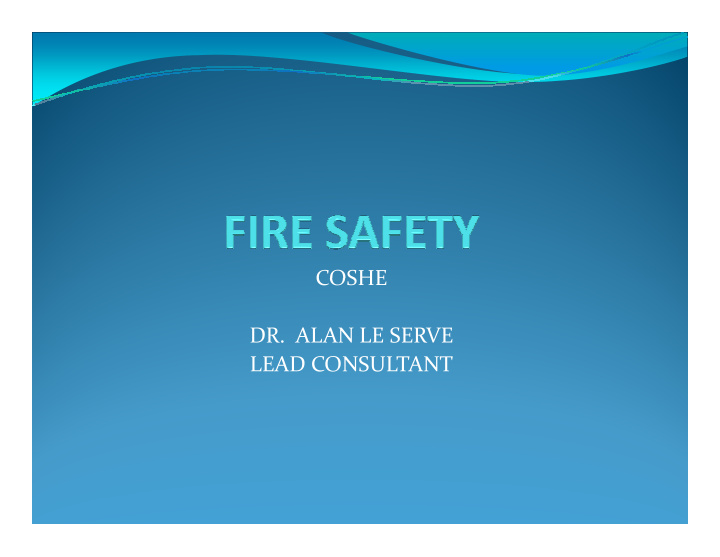



COSHE COSHE DR. ALAN LE SERVE LEAD CONSULTANT
FIVE STEPS IN FIRE RISK ASSESSMENTS � identify potential fire hazards; � identify those workers most at risk of fire; � evaluate the risks and implement improvements; � keep record of findings and actions taken; and � constantly review and implement changes as necessary.
1. IDENTIFY POTENTIAL FIRE HAZARDS Look for any: � sources of ignition; � sources of combustible material; and � processes in the workplace that could be a fire hazard.
FLAMMABLE LIQUIDS........ ……being stored next to boxes, ……being stored in direct sunlight. paper and other combustible material.
LOOK FOR TELL-TALE SIGNS...... A Woodworking Factory A faulty socket An electrical cable jammed into the socket with a piece of wood and a can of flammable glue amongst all the wood!
SOME PROCESSES CAUSE SPARKS AND GENERATE HEAT..... WELDING CUTTING
FACTORY FIRES KILL...... Garment factory fire kills at least 25 workers in Bangladesh. At least 25 Bangladeshi garment workers died and over 100 others were hurt in a fire that broke out in a large garment factory close to the Bangladeshi capital, Dhaka, on the 14 December 2010.
FACTORY FIRES KILL...... Another factory fire - Friday, July 8 2011 THE second factory fire this week took place yesterday when Lil Industries Ltd — a woodworking factory — at the corner of Maingot Street and Riverside Avenue in Mt Hope was gutted despite the best efforts of firemen to contain the blaze. This fire comes two days after Thermoplas Limited, a plastic factory, at Tissue Drive at Trincity Industrial Estate, Trincity, was almost destroyed by an inferno which was started after machinery malfunctioned and exploded. A nationwide investigation into safety standards at factories is to be conducted by the Trinidad and Tobago Fire Service following these two factory fires. Both fires were caused by malfunctioning equipment, sources said, which led to flames coming into contact with material which ignited.
2.IDENTIFY THOSE WORKERS MOST AT RISK Look carefully at this Caribbean garment worker. Not only is the fire extinguisher blocked but the fire exit is LOCKED
CLEAR AISLES ARE NOT ONLY GOOD FOR EFFICIENCY, THEY ARE GOOD FOR ESCAPE IN CASE OF FIRE OR
3. EVALUATE THE RISKS AND IMPLEMENT IMPROVEMENTS Such as - � remove any sources of ignition; � reduce/tidy any combustible material; � ensure good housekeeping; � ensure good housekeeping; � check wiring etc. in good condition; � ensure all machines are maintained and lubricated; � store any flammable liquids in fire-resisting cabinet; � keep lids or tops on flammable liquids/rags when in use; � operate a NO SMOKING policy at all times; and �� � install warning signs such as ‘No Naked Flame, No Smoking’, etc.
�������� ��� ������������ �������������������
A NEAT AND TIDY FACTORY REDUCES THE FIRE RISK
�� ENSURE ARRANGEMENTS FOR DETECTING, GIVING WARNINGS, AND RESPONDING TO FIRES...
�������� ��� ������������������ �������������������
ENSURE ALL WORKERS HAVE A SAFE MEANS OF ESCAPE...... Once the fire alarm goes off, all workers know their best route to safety. They know what to do, ensuring no panic and check that everyone is out of the building. Regular fire drills are essential.
�� TRAIN WORKERS IN FIRE SAFETY...... In some factories, workers have been trained specifically in fire fighting, especially in the use of equipment. These workers form fire- These workers form fire- fighting teams on each floor/ section of the factory. They are easily identified by �� badges or high visibility vests so that every worker knows who they are.
�������� ��� ������������������������� ������������������� ��� �������� �������������������
USE THE CORRECT FIRE-FIGHTING EQUIPMENT � Class A : fires involving solid materials – usually organic material such as wood, paper, material etc. These can be dealt with by water, foam or multi-purpose powder fire extinguishers. � Class B: fires involving liquids or liquefiable solids – such as paints, oils and fats. In these fires it is best to use foam, carbon dioxide or dry powder types of extinguishers. Carbon dioxide extinguishers are suitable for fires involving electrical equipment – NEVER use water on electrical fires.
� Class C : fires involving gases – again as shown in the picture, dry powder extinguishers can be used on this type of fire. � Class D : fires involving metals – none of the above extinguishers would be suitable for these fires. � Class F : fires involving cooking oils and fats. As with class D fires, specialist advice should be sought if, after you have carried out a fire risk assessment, you consider that these may be a problem.
DO NOT ATTEMPT TO USE FIRE FIGHTING EQUIPMENT THAT IS FAULTY OR DIFFICULT TO ACCESS...... IF THE EQUIPMENT IS BLOCKED, OUT OF CHARGE, OR IN A POOR CONDITION – SIMPLY EVACUATE A fire extinguisher that is in an A blocked fire hose/reel. How unsafe condition. It will never are workers supposed to reach work and workers would be best it in the case of a fire? advised not to touch it.
4. CONDUCT PERIODIC DRILLS AND RECORD FINDINGS Such as: � date of the fire-drill; � evacuation times; evacuation times; � the nature of the drill; and � any observations/remedial action required (e.g. have evacuation times improved/gotten worse?). Such records will help you to review/fine-tune your whole emergency plan.
5. REVIEW AND REVISE Any emergency plans may have to adapt as changes are introduced into the factory. You may: � have taken on more workers; � be using new processes or chemicals; � have a new extension to the factory; or � some of your key fire-fighting workers may have left the company.
Recommend
More recommend